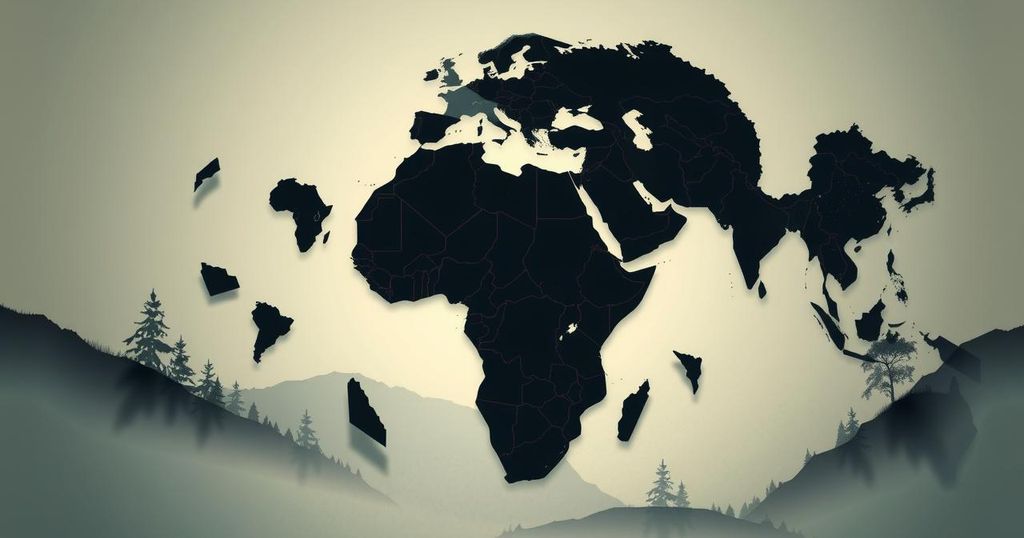Protests in Kinshasa reflect public outrage toward Rwandan support for the M23 rebels, who have seized control of Goma amidst ongoing violence. UN experts assert Rwandan military involvement, providing training and sophisticated weaponry to the rebels. Despite President Kagame’s denials, rising evidence indicates his government’s backing for the M23, linked to historical tensions dating back to the 1994 Rwandan genocide. The M23’s control of lucrative resources, combined with military support, poses significant challenges for regional stability and humanitarian efforts, necessitating urgent international intervention.
In recent protests in Kinshasa, the capital of the Democratic Republic of Congo, citizens expressed their anger toward Rwandan President Paul Kagame, accusing him of supporting the M23 rebel group, which has gained control over significant portions of Goma. The United Nations has echoed these allegations, claiming that the Rwandan army effectively governs M23 operations, providing training and advanced weaponry to the group.
Goma, encircled by a volcanic landscape and located near Lake Kivu on the Rwanda border, is a vital economic and humanitarian center within North Kivu province. This city has seen an influx of displaced individuals seeking refuge from ongoing conflicts between the M23 rebels and the Congolese military since late 2021, bringing the population to an estimated two million.
Recent eruptions of violence in Goma have left the streets strewn with bodies, and significant disruptions to communication and utilities have hindered accurate information flow. UN peacekeeping chief Jean-Pierre Lacroix confirmed the presence of Rwandan troops supporting the M23 rebels, although specific troop numbers remain uncertain.
Despite consistent denials from President Kagame regarding military support for the M23, increasing evidence links Rwanda to the rebel operations. Richard Moncrief from the International Crisis Group noted that allegations against Rwanda have escalated, indicating a shift from denial to justifying military actions based on national security concerns.
Rwanda’s Ministry of Foreign Affairs emphasized that the unending conflict threatens its security and calls for Rwanda’s defensive posture in the region. Kagame’s underlying motives are deeply rooted in the consequences of the 1994 Rwandan genocide, which he considers a lingering threat posed by Hutu militias in DR Congo.
The unrest in the region is intertwined with historical tensions, including the ongoing activities of groups like the Democratic Forces for the Liberation of Rwanda (FDLR), which continues to pose security concerns. Kagame linked the resurgence of M23 activity to stagnant measures taken by the Congolese government regarding the FDLR, asserting the necessity of decisive action.
Critics argue that the M23’s aggressive tactics may primarily serve as a demonstration of Rwanda’s influence over North Kivu politics, particularly following heightened tensions. The M23 has evolved from a previously disbanded group and now seeks control over economically advantageous regions, including lucrative sources of minerals such as coltan.
Despite the mandate limiting the UN peacekeeping mission’s offensive capabilities, regional forces have struggled to deter the M23, revealing the rebel group’s organizational sophistication. Reports indicate that M23 recruits undergo extensive training near the Rwanda border, where they learn military tactics and operational strategies under Rwandan supervision.
UN analyses have identified that the M23 has benefited greatly from Rwandan military support, including advanced weaponry and tactical capabilities not accessible to other armed groups in the region. Instances of collusion with Ugandan forces have emerged as well, further complicating the conflict dynamics, although Uganda denies such allegations.
Rwanda’s recent military operations have shown a marked increase since Kagame criticized the lack of cooperative efforts against Hutu groups by his Congolese counterpart. Instances of Rwandan soldiers allegedly stationed in border towns near Goma have been documented through geolocated images.
The M23’s strategic decisions, such as their recent takeovers of crucial mining sites in Rubaya, underline their objective to consolidate mineral trade profits. The group reportedly collects substantial revenues through coltan taxes, solidifying their financial position through direct exports to Rwanda.
Kagame has dismissed UN reports highlighting Rwandan involvement as biased representations of the conflict, affirming his stance that the FDLR remains the core issue requiring resolution. Current diplomatic efforts led by the East African Community are ongoing, although tensions remain high, with Kagame maintaining his focus on addressing the FDLR’s sustained presence as pivotal to regional stability.
The conflict in the Democratic Republic of Congo (DRC) has been shaped by historical grievances dating back to the 1994 Rwandan genocide, resulting in ongoing tensions involving various armed groups, notably the M23, which claims to represent Tutsi interests in eastern DRC. After years of intermittent rebellion and previous peace efforts, the M23 resurfaced in 2021, leading to renewed skirmishes against the Congolese military. The area surrounding Goma is strategically significant due to its vast mineral resources, attracting both local and foreign actors interested in exploiting these assets amidst ongoing violence. Accusations of Rwandan support for the M23 have consistently surfaced, corroborated by UN expert groups that claim to have identified Rwandan military involvement in the region. The complexities of this conflict are further exacerbated by regional dynamics, including the roles of neighboring countries like Uganda, which has also been implicated in providing support to the M23. The humanitarian implications of this ongoing crisis are profound, with a significant number of displaced individuals and a pressing need for effective international intervention. This situation remains a prime example of how historical conflicts can shape modern geopolitical landscapes, often with dire consequences for local populations caught in the crossfire of regional power struggles. Understanding this multifaceted context is essential for grasping the underlying motivations and actions of the various actors involved in the DRC’s ongoing unrest.
The ongoing conflict in the Democratic Republic of Congo, particularly in Goma, highlights the complexities of regional dynamics involving Rwanda and M23 rebels. With persistent accusations of Rwandan military support coupled with the historical context of the Rwandan genocide, the situation remains precarious. The humanitarian implications are severe, warranting urgent international attention to mitigate the turmoil affecting millions. As diplomatic efforts continue, the region’s stability hinges on addressing fundamental grievances tied to historical injustices.
Original Source: www.bbc.co.uk




